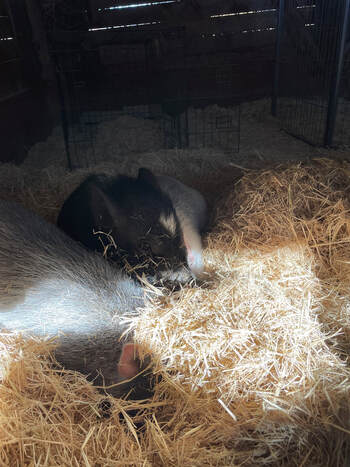|
Nora Bahr UC Davis undergraduate, 4th year Major: Wildlife, Fish, and Conservation Biology Carebear and I cuddling It’s been quite a while since my last blog, and a lot has changed on the ranch since then! The pigs and the minis are doing well, and the garden is looking incredible. These past few weeks, we’ve all been focusing more centrally on our research. Our little pigs have been exposed to an abundance of people, regularly interacting with our colleagues and families, so their comfort level approaching strangers has really improved! But, how are we to know if our animals are actually capable of providing therapeutic services for those in need? To answer this question, we need to first design an experiment. In order to fuel some inspiration for our experiment, I did a review and presentation of a primary literature study, entitled “Temperament test for donkeys to be used in assisted therapy” (Gonzalez-De Cara et al., 2017). The goal of this study was to gauge donkey’s reactions and attitudes toward touch, sound, and human interaction to determine their suitability for Animal-Assisted Therapy (AAT). 36 donkeys already used to human contact were tested and put through 2 categories of tests: sensory and temperament tests. Any other behaviors (sniffing stimuli, touching stimuli, etc.) were also recorded. First, let’s walk through the sensory tests. The first sensory test concerned sound: a transmitter played a 70 decibel sound while the donkey was eating. Next came the tactile tests: a tool called a Von Frey Filament (essentially a small wire attached to a handle used to gauge how sensitive different body parts are to touch) was applied to various parts of the body. The Stifle-haunch Axis Stimulation test was then performed, during which objects of various textures are moved along the haunches of each donkey. These sensory and tactile tests could be applicable to what we’re trying to accomplish with the pigs, but we may need to make some modifications. The pigs are not the most sensitive or responsive to sound, but applying some kind of pressure or tool to various parts of their bodies would be helpful in determining their tactile sensitivity, especially because they will eventually be receiving daily pets from strangers. The temperament tests included fearfulness tests (reactions to an object placed in the arena with the donkey, crossing an unknown surface, and reactions to a surprising stimulus) and reactivity to humans tests. There was an unfamiliar passive human test, in which a stranger stands in the arena with the animal, and an unfamiliar active human test, in which a stranger moves towards the donkey and attempts to touch the back for 1 second and the muzzle for 3 seconds. These tests seemed much more applicable to the pigs than the sensory tests: the pigs will be exposed to novel objects/surfaces and to unfamiliar humans very frequently as therapy animals. The study found that surprise stimuli were more disruptive and that the animals were more reactive to visuals rather than sounds and to thinner filaments rather than thicker ones. I presented these findings to the Green Care Lab team, and then we acted out the experiment, pretending to be researchers and donkeys. This hands-on approach to reading primary literature was extremely helpful for me, as I often find it difficult to visualize scientific experiments. Watching my teammates act as donkeys worked surprisingly well in helping me see just how useful an experiment similar to this one could be to determine how our little piggies can help people! The next step? Designing the methods section for our experiment and collecting the materials we’ll need! This study absolutely gave me a solid foundation to build an experiment on. Soon, the pigs will be tested in their very own scientific study. Exciting things to come! The three siblings in a pig pile on a cold morning
2 Comments
Leave a Reply. |
Green Care Blog
Here you can find blog posts from each Green Care Lab intern. We'll be talking about our research process, the benefits of Green Care therapy, and sharing pictures of our work. Follow along with us! Authors
All
Archives
July 2023
|


